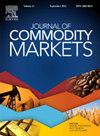金融领域可持续性风险的量化模型
IF 4.5
4区 经济学
Q1 BUSINESS, FINANCE
引用次数: 0
摘要
我们的目标是首次在金融领域定量地表述可持续性风险(Srisk),并通过实证分析对这一表述进行验证。将现有研究支持的一般可持续性概念应用于金融,提出了一种新的风险金融和定量模型,该模型由可持续资产与传统资产之间的价格差异定义,其特征是对市场风险的均值回归、周期性和多样化影响。然后,利用ESG指数和相应的股票指数对模型的参数估计结果证实了这三个特征,并表明ESG指数的预期收益优于股票指数的收敛性,从而证明了在配对交易中获得收益的可行性。最后,我们通过对可持续资产价格的计量经济学分析,讨论了该模型关于Srisk的三个特征的稳健性,以及Srisk均值回归由于基本面变化而产生的制度转换。本文章由计算机程序翻译,如有差异,请以英文原文为准。
A quantitative model of sustainability risk in finance
We aim to formulate sustainability risk (Srisk) quantitatively in finance for the first time and validate the formulation by conducting empirical analyses. Applying the general sustainability concept to finance supported by existing studies proposes a new financial and quantitative model of Srisk defined by the price differences between sustainable and conventional assets and characterized by mean-reversion, cyclicity, and diversification effects on market risk. Then, the parameter estimation results of the model using ESG and the corresponding stock indexes confirm these three characteristics and indicate the convergence of expected returns of ESG indexes over stock indexes, resulting in the feasibility of securing returns in the pairs trading. Finally, we discuss the model’s robustness regarding Srisk’s three characteristics and the regime-switching of Srisk’s mean-reversion due to fundamental shifts by conducting econometric analyses of sustainable asset prices.
求助全文
通过发布文献求助,成功后即可免费获取论文全文。
去求助
来源期刊

Journal of Commodity Markets
Multiple-
CiteScore
5.70
自引率
2.40%
发文量
53
期刊介绍:
The purpose of the journal is also to stimulate international dialog among academics, industry participants, traders, investors, and policymakers with mutual interests in commodity markets. The mandate for the journal is to present ongoing work within commodity economics and finance. Topics can be related to financialization of commodity markets; pricing, hedging, and risk analysis of commodity derivatives; risk premia in commodity markets; real option analysis for commodity project investment and production; portfolio allocation including commodities; forecasting in commodity markets; corporate finance for commodity-exposed corporations; econometric/statistical analysis of commodity markets; organization of commodity markets; regulation of commodity markets; local and global commodity trading; and commodity supply chains. Commodity markets in this context are energy markets (including renewables), metal markets, mineral markets, agricultural markets, livestock and fish markets, markets for weather derivatives, emission markets, shipping markets, water, and related markets. This interdisciplinary and trans-disciplinary journal will cover all commodity markets and is thus relevant for a broad audience. Commodity markets are not only of academic interest but also highly relevant for many practitioners, including asset managers, industrial managers, investment bankers, risk managers, and also policymakers in governments, central banks, and supranational institutions.
 求助内容:
求助内容: 应助结果提醒方式:
应助结果提醒方式:


